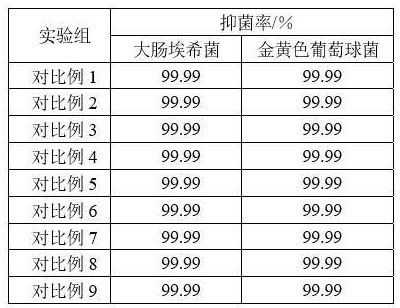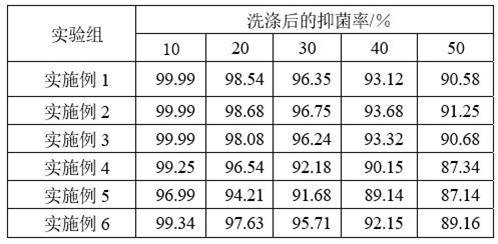Antibacterial fabric for sofa cushion and production process of antibacterial fabric
A technology of antibacterial fabric and production process, which is applied in the fields of biochemical fiber treatment, textile and papermaking, fiber treatment, etc. It can solve the problems of poor antibacterial and durable performance, and achieve the effect of improving antibacterial and durable performance, improving dispersion performance, and uniform doping
- Summary
- Abstract
- Description
- Claims
- Application Information
AI Technical Summary
Problems solved by technology
Method used
Image
Examples
preparation example 1
[0033] Base fabric preparation: According to the mass ratio of 1:4, polyester fiber is used as ground yarn and cotton fiber is used as veil for weaving. Obtain cotton matrix fabric 1;
[0034] Preparation of modified starch nanocrystalline particles: Add waxy cornstarch to 1.2mol / L sulfuric acid at a mass ratio of 1:10, stir at room temperature for 70 hours, centrifuge and collect the lower precipitate, wash with deionized water until After the washing solution is neutral, freeze-dry and grind through a 500-mesh sieve to obtain modified starch nanocrystalline particles 1;
[0035] Preparation of modified antibacterial particles: Add tetrabutyl titanate to absolute ethanol at a mass ratio of 1:3, stir magnetically at 45°C for 10 minutes, collect the sol, and weigh 45 Mix 1 part of sol solution, 3 parts of 5% lithium silicate solution by mass fraction and 0.1 part of silane coupling agent and add to the stirring device, stir magnetically at 45°C for 3h to obtain a mixed sol sol...
preparation example 2
[0037]Base fabric preparation: According to the mass ratio of 1:4.5, polyester fiber is used as ground yarn and cotton fiber is used as veil for weaving. Obtain cotton matrix fabric 2;
[0038] Preparation of modified starch nanocrystalline particles: Add waxy cornstarch to 1.3mol / L sulfuric acid at a mass ratio of 1:12, stir at room temperature for 71 hours, centrifuge and collect the lower precipitate, wash with deionized water until After the washing solution is neutral, freeze-dry and grind through a 500-mesh sieve to obtain modified starch nanocrystalline particles 2;
[0039] Preparation of modified antibacterial particles: Add tetrabutyl titanate to absolute ethanol at a mass ratio of 1:4, stir magnetically at 47°C for 12 minutes, collect the sol, and weigh 47 1 part of sol solution, 4 parts of 5% lithium silicate solution by mass fraction and 0.2 part of silane coupling agent were mixed and added to a stirring device, and magnetically stirred at 47°C for 4 hours to ob...
preparation example 3
[0041] Base fabric preparation: According to the mass ratio of 1:5, polyester fiber is used as ground yarn and cotton fiber is used as veil for weaving. Obtain cotton matrix fabric 3;
[0042] Preparation of modified starch nanocrystalline particles: Add waxy cornstarch to 1.5mol / L sulfuric acid at a mass ratio of 1:15, stir at room temperature for 72 hours, centrifuge and collect the lower precipitate, wash with deionized water until After the washing solution is neutral, freeze-dry and grind through a 500-mesh sieve to obtain modified starch nanocrystalline particles 3;
[0043] Preparation of modified antibacterial particles: Add tetrabutyl titanate to absolute ethanol at a mass ratio of 1:5, stir magnetically at 50°C for 15 minutes, collect the sol, and weigh 50 parts by weight. 5 parts of 5% lithium silicate solution and 0.5 parts of silane coupling agent were mixed and added to a stirring device, and magnetically stirred at 50°C for 5 hours to obtain a mixed sol; put th...
PUM
| Property | Measurement | Unit |
|---|---|---|
| Particle size | aaaaa | aaaaa |
| Length | aaaaa | aaaaa |
Abstract
Description
Claims
Application Information
 Login to View More
Login to View More - R&D
- Intellectual Property
- Life Sciences
- Materials
- Tech Scout
- Unparalleled Data Quality
- Higher Quality Content
- 60% Fewer Hallucinations
Browse by: Latest US Patents, China's latest patents, Technical Efficacy Thesaurus, Application Domain, Technology Topic, Popular Technical Reports.
© 2025 PatSnap. All rights reserved.Legal|Privacy policy|Modern Slavery Act Transparency Statement|Sitemap|About US| Contact US: help@patsnap.com



